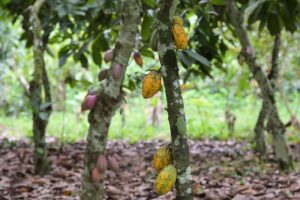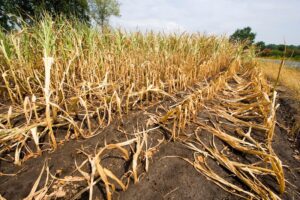It has been more than one year since the gavel came down at the last UN biodiversity summit, where almost every country in the world agreed on a plan to protect nature.
The Kunming-Montreal Global Biodiversity Framework was signed off at the COP15 summit in Montreal, Canada in December 2022. (See Carbon Brief’s in-depth summary of the key outcomes.)
The landmark deal contained a number of goals and targets for countries to achieve over the coming years – such as setting aside land for wildlife, reducing pesticide risks and restoring ecosystems.
In the months since, more nature pledges have been announced, a new biodiversity fund was established and more science showing the impacts of humans on nature has been published.
Countries will gather at the next UN biodiversity summit, due to be held in Colombia this October, to take stock of progress since the deal was given the green light and submit new national plans outlining how they will protect biodiversity.
Carbon Brief has taken an in-depth look at progress on individual nature issues and the key biodiversity updates since the COP15 summit.
- What was agreed at the UN biodiversity summit in Montreal?
- What has happened since the Global Biodiversity Framework was adopted?
- Key negotiation issues
- What do we know about the next UN biodiversity summit?
What was agreed at the UN biodiversity summit in Montreal?
The UN biodiversity summit takes place every two years, unlike the climate COP, which takes place annually.
At COP15 – the last round of biodiversity talks in Montreal in December 2022 – almost every country in the world agreed to a landmark deal to repair nature.
The Kunming-Montreal Global Biodiversity Framework (GBF) included four long-term global goals and 23 specific targets, with an overall mission of halting and reversing biodiversity loss by 2030.
Some of the key targets include conserving 30% of the world’s land and 30% of the ocean by 2030, reducing the impact of invasive species, cutting pesticides, sustainably managing agriculture and prioritising involvement of Indigenous peoples and local communities in different ways.
Alongside the overall framework, dozens of other decisions were made around the more technical aspects of the negotiations, including figuring out ways to monitor national progress and gather finance to fund action, particularly in lower-income countries.

Although the agreements made at the summit are not legally binding, nations also agreed on a plan to report on, review and voluntarily increase their ambitions to tackle biodiversity loss. This is similar to the plan drawn up to implement the Paris Agreement for climate change.
A lack of implementation was widely cited as one of the major factors behind the failure of the Aichi targets, the last set of global biodiversity aims.
Although the COP15 agreement was widely seen as a success, some countries – particularly the Democratic Republic of Congo – felt frustrated and outraged at the manner in which the GBF was given the green light.

In the final stages of the summit, the deal was seen to be quickly gavelled through by summit president, Chinese environment minister Huang Runqiu, despite objections from the DRC minutes earlier in the plenary.
Following the close of the plenary, there were arguments over the manner in which the final approval happened, but all countries eventually supported the deal.

In the wake of the agreement, UN secretary general António Guterres said that “we are finally starting to forge a peace pact with nature”.
Canadian environment minister Steven Guilbeault said that the GBF is a “major win for our planet and for all of humanity”, which will chart a course “away from the relentless destruction of habitats and species”.
The International Indigenous Forum on Biodiversity welcomed the “timely recognition” of Indigenous peoples and local community contributions, roles, rights and responsibilities to nature. A statement from the group said:
“We have spoken and you have heard us, let us now put those words into action.”
What has happened since the Global Biodiversity Framework was adopted?
Several events and meetings since COP15 have addressed nature and biodiversity in different ways.
On 15 February 2023, Dr David Cooper took over from Elizabeth Maruma Mrema as the new acting executive secretary of the Convention on Biological Diversity (CBD). The CBD is an international treaty established in 1992 with the objective of conserving and sustainably using biodiversity, and ensuring the fair sharing of benefits from the use of genetic resources.
Before his appointment, Cooper had assisted the CBD secretariat as deputy executive secretary, contributing to a “successful finalisation and adoption of the Kunming-Montreal Global Biodiversity Framework”, according to the CBD. He was a lead author of three editions of the Global Biodiversity Outlook and other assessments.
Mrema was appointed deputy executive director of the UN Environment Programme.
March saw the emergence of the High Seas Treaty, a legally binding global agreement for conserving and sustainably using areas of the ocean beyond national jurisdictions – also known as the “high seas” or international waters. Carbon Brief reported that the treaty “provides the framework for establishing protected areas where previously there had not been a clear mechanism for doing so”. (For more on the high seas treaty, see: Oceans.)
The Amazon Summit, held in August last year, gathered leaders of the eight Amazon basin countries, who delivered the Belém Declaration. The document will strengthen the Amazon Cooperation Treaty Organization to prevent the rainforest “from reaching the point of no return”. The summit’s outcomes were labelled as “hopeful, but insufficient” by various civil and Indigenous organisations for having no specific targets for curbing deforestation.
In late 2023, countries from the Amazon, the Congo Basin and south-east Asia agreed to protect their rainforests and boost nature finance during the Three Basins Summit in the Republic of the Congo. However, experts told Carbon Brief at the time that the meeting failed to reach a unified alliance and was, ultimately, “underwhelming”.
October marked the official end of COP15 with a meeting in Nairobi, which served to finish off some “outstanding business in Montreal” and advance the recommendations from the Subsidiary Body on Scientific, Technical and Technological Advice (SBSTTA) on implementation and review. Delegates also issued a draft recommendation on climate change and biodiversity.
Key negotiation issues
Over the past year, there have been a number of summits, finance pledges and intergovernmental talks relating to biodiversity.
Below, Carbon Brief outlines the progress on the key biodiversity COP negotiation topics and related issues in the months since Montreal – from movement on the “30 by 30” goal to the focus on Indigenous rights.
Halting and reversing biodiversity loss
Back in Montreal, countries agreed that the overall mission of the GBF should be to “halt and reverse biodiversity loss by 2030”.
The GBF has been likened to the “Paris Agreement for nature”, with some comparing the 2030 goal of halting and reversing biodiversity loss to the aspirational 1.5C temperature limit.

After the GBF was agreed, Carbon Brief spoke to a range of biodiversity scientists who said that halting and reversing biodiversity loss by 2030 would be incredibly challenging.
A landmark report released in 2019 by the world’s biodiversity authority, the Intergovernmental Science-Policy Platform on Biodiversity and Ecosystem Services (IPBES), found that one million animal and plant species now face extinction. This is more than at any other point in human history.
Across the world, populations of mammals, birds, amphibians, reptiles and fish decreased by an average of 69% between 1970 and 2016, according to a 2022 WWF report on more than 30,000 animal populations. In tropical central and South America, the animal populations covered by the study fell by an average of 94% over this period.
Scientists also told Carbon Brief that achieving the mission would largely be decided by meeting the targets of the GBF that tackle the direct causes of biodiversity loss.
These include target 18, which addresses subsidies harmful to biodiversity; target 7, which addresses pollution; and targets 5 and 9, which address the “sustainable use” of biodiversity. (Progress on several targets is discussed in more detail below.)
One issue that negotiators have continued to work on since the GBF was agreed is developing a set of indicators for measuring biodiversity loss.
While many people associate “biodiversity” with iconic species and tropical rainforests, the term actually covers the whole spectrum of Earth’s biological diversity, ranging from the organisation of genes within organisms to the communities of animals and plants that make up ecosystems. This complexity makes biodiversity loss particularly difficult to measure.
At COP15, countries decided to set up a technical group to develop biodiversity loss indicators ahead of COP16, spearheaded by Colombia and the UK. Comprising 45 experts, the group has met several times virtually in 2023 and will meet for in-person discussions in Cambridge, England in March of this year.
30 by 30
One aim that grabbed the attention of politicians, media, activists – and even celebrities – at COP15 was the pledge to protect 30% of the world’s land and seas for nature by 2030, commonly referred to as “30 by 30”. It is contained within target 3 of the GBF.

The fight to get 30 by 30 into the GBF was spearheaded by a group of countries calling itself the High Ambition Coalition for Nature and People (HACN&P). It is led by Costa Rica and France, with the UK acting as a co-chair for the ocean component of the pledge.
Since COP15, the HACN&P set up a secretariat directed by former Costa Rican biodiversity negotiator Rita El Zaghloul.
During an interview at the COP28 climate summit in Dubai in December 2023, El Zaghloul told Carbon Brief that with the GBF agreed, the HACN&P has shifted its focus to ensuring the most vulnerable countries have the tools required to meet the target.
At COP28, she announced that the HACN&P had created a new “30 by 30 solutions toolkit” and a financial and technical “matchmaking” service. Explaining the purpose of these tools to Carbon Brief, she said:
“Because it was HACN&P that started the 30 by 30 movement, it is also our responsibility to ensure that countries have the sufficient support and tools to meet the target.
“We know that it is an ambitious target, because we have to move from approximately 17% on land and 8% on oceans [that is currently protected] to 30% on both. Many of the megadiverse countries are developing countries and small island developing states, so we need to provide them with the tools.”
Elsewhere at COP28, China surprised delegates by announcing that it was joining the HACN&P. The announcement came from COP15 president and China environment minister Huang Runqiu via videolink at a high-level session on 30 by 30.

El Zaghloul told Carbon Brief that the announcement came after more than two years of talks with China, who were initially reluctant to join the initiative while still maintaining the “neutral” role of COP15 president.
As of the end of COP28 in December 2023, 118 countries had joined the HACN&P. This compares to 114 in December 2022. (There are 196 countries, including the EU, that are party to the CBD. All of these countries have committed to 30 by 30 through the GBF.)
Finance
At COP15 in Montreal, the gavel went down adopting the GBF and its finance package amid controversy and objections from biodiverse developing countries.
The final finance target seeks to mobilise “at least $200bn per year” by 2030 from “all sources” – domestic, international, public and private. For comparison, the biodiversity finance gap for conservation is estimated at roughly $700bn per year for this decade.
Developed countries – along with others that “voluntarily assume” their obligations – are expected to “substantially and progressively increase” their international finance flows for nature “to at least $20bn per year by 2025 and to at least $30bn per year by 2030”, according to the GBF’s Target 19l.

Despite calls from many developing countries for a distinct fund housed under the COP, COP15 requested the Global Environment Facility (GEF) set up a special trust fund. This would be called the “Global Biodiversity Framework Fund” (GBF Fund) and be established “in 2023, and until 2030” to receive “financing from all sources”.
On June 29 last year, the GEF’s governing board approved plans to set up this “game-changing” new fund to finance the Framework’s implementation.
The GEF’s governing board approved plans to establish the fund on 29 June last year. A month later, at the GEF assembly in Vancouver, 186 countries ratified and officially launched the GBF Fund.
At the GEF assembly, COP15 hosts Canada contributed an initial capitalisation of C$200m ($147.3m), while the UK pledged £10m ($12.6m).
As much as 20% of the funds are intended for supporting Indigenous-led initiatives to protect and conserve biodiversity.

Indigenous groups – often sidelined from direct access to conservation funding – welcomed the dedicated allocation. Brazil’s Indigenous minister Sonia Guajajara pointed out that this “should not just be an aspirational criterion, but a concrete target that needs to be constantly updated” and called for “shared governance mechanisms that include recipient countries”.
Separately, at least 36% of the fund’s resources are to support small island developing states and least-developed countries.
At the assembly, Cuba and Honduras called for “simplified processes for obtaining” funding, the Earth News Bulletin reported. At the same time, the DRC, Namibia, Yemen and the Gambia “urged” more direct access to funds and minimising transaction costs.
At a side event on the sidelines of the UN general assembly in September, Germany pledged the final €40m ($43.3m) to put the fund into operation.
On Nature Day at COP28, Japan then pledged ¥650m ($43.8m). While this took the fund’s initial total capitalisation to about $247m, this falls far short of the “at least $20bn per year by 2025” target that developed countries were to raise. The US and EU, who supported and “welcomed” the fund, are yet to commit any new money.
The fund’s governing body will meet for the first time on 8 and 9 February this year in Washington DC to discuss its budget, business plan and how resources are allocated, with projects set to be funded by the end of 2024.
Projects backed by all eligible countries will have to go through consecutive selection rounds for funding based on criteria, including their potential to generate global environmental benefits, alignment with the GBF’s goals and National Biodiversity Strategies and Action Plans (NBSAPs), and their ability to raise resources from the private sector.

Not all the money raised will go to funding biodiversity projects directly: it will also have to cover staff costs, travel, consultants, monitoring and independent evaluation.
Additionally, if the fund’s current budget request is approved, it will have to pay the World Bank – the GEF’s host– an indirect charge of 11% on all direct costs for administrative support – a 300% increase from last year.
The UN Environment Programme’s State of Finance for Nature 2023 report, released at COP28, found that public finance still accounts for the majority of conservation spending in the GBF’s first year. At the same time, it found that contributions from biodiversity offsets and credits grew sharply in 2022 as countries including the UK, France and Australia rolled out new nature markets.
The report also noted that philanthropy – “driven by support for 30 by 30” – and private finance mobilised by debt instruments such as blue bonds and rhino bonds grew last year as well. But, it added, these small numbers paled in comparison with $7tn in nature-negative investments made the same year.
Implementation
Ensuring that the targets contained within the GBF are actually implemented by countries will be the major challenge in the coming years, experts tell Carbon Brief.
Details for how the agreement should be implemented – the so-called “teeth” of the deal – are contained within Section J of the GBF itself and a separate document called “mechanisms for planning, monitoring, reporting and review”. (It is worth noting that the GBF and its underlying documents are not legally binding.)
The agreed plan for how the GBF should be implemented by countries follows three key steps – sometimes referred to as “present, review and ratchet”. This closely mirrors the implementation schedule of the Paris Agreement.
Section J of the GBF specifies that countries should present national biodiversity strategies and action plans, or “NBSAPs”, that are “in alignment” with the GBF and its goals and targets. The underlying document adds that this should be done “by COP16”.
Since the end of COP15, France, the EU, Luxembourg, Hungary, Japan and Spain have submitted updated NBSAPs. The UK has indicated it will release its new NBSAP in May of this year.
In September 2023, an “accelerator partnership” to “fast-track and upscale” new NBSAPs was officially launched at New York Climate Week, after first being agreed at COP15. The initiative is headed by Colombia and Germany, with the support of various UN bodies.
As for the “review” step, countries have agreed to conduct a global analysis of whether NBSAPs align with the GBF at COP16 and hold a “global review” of progress at COP17 and COP19.
After this, countries “may take the outcome of the global reviews into account in future revisions and implementation of their” NBSAPs. This is the “ratchet” element of the implementation mechanism.
In October 2023, negotiators met in Nairobi to officially close COP15. The aim of this meeting was to tie up loose ends remaining from the landmark agreement of the GBF in Montreal in 2022.
The event brought together scientific and technical experts to give advice on what should be included in the global review earmarked for COP17 in 2026. Bernadette Fischler Hooper, the head of global advocacy at WWF International, told Carbon Brief:
“The technical experts and scientific experts discussed what should be in this report. So it was very focused on what that report should contain.”
Nature-based solutions
The use of nature to mitigate and adapt to climate change – known as nature-based solutions – featured a number of times in the GBF’s targets.
At COP28 in Dubai, nature-based solutions were also discussed at different stages. The global stocktake text – a key outcome of the summit that showed how countries can increase action to meet climate goals – “encourages” the implementation of nature-based solutions.

A report released in June by the International Institute for Sustainable Development recommended ways to ensure that nature-based solutions will boost biodiversity and ecosystems.
In a list of draft recommendations from the final round of intergovernmental talks on nature-based solutions, the co-chairs suggested ways to support their use.
These include setting up a database of policies related to nature-based solutions to enable learning between countries, analysing the technical tools available to support implementing such solutions and making a how-to guide for accessing finance for these projects.
At COP28, more than 150 companies and financial institutions said they would increase investments in nature-based solutions.
At COP16, nature-based solutions will likely feature in many national biodiversity action plans and will continue to be one of the key talking points, experts tell Carbon Brief.
For example, Spain intends to prioritise a number of different areas including nature-based solutions over the next few years to meet its climate and biodiversity targets, according to its revised NBSAP.
Invasive species
Invasive alien species are animals, plants or other organisms that have spread into places outside their natural habitats. These can negatively impact both nature and people, according to IPBES.
Target 6 of the GBF aims to reduce the establishment and introduction of invasive alien species by 50% by 2030.

Since the GBF was agreed at COP15, there have been advances in the knowledge of the distribution of invasive species across the world and the ways countries can handle biological invasions.
In September last year, IPBES published an assessment report on invasive alien species, which notes that humans have introduced 37,000 invasive alien species.
The report, based on more than 13,000 scientific studies, says that despite this, more than 80% of countries lack national legislation or regulations to address invasive species. However, it outlines three frameworks for governments to manage biological invasions, from introduction pathway management to species-based and site-based management. (For more, read Carbon Brief’s coverage of the IPBES report.)
According to reporting by the Earth Negotiations Bulletin (ENB), the CBD’s SBSTTA Nairobi meeting in October emphasised the need to develop strategies to simultaneously address two main causes of biodiversity loss – climate change and invasive alien species – and to step up collaboration among environmental agreements to implement the GBF.
It also reported that the SBSTTA adopted eight resolutions, including one on invasive alien species. Among other things, such a resolution addresses how to identify and minimise cross-border e-commerce of live organisms or manage invasive alien species by preventing risks from climate change.
The secretariat of the CBD issued a document providing draft voluntary guidance and advice on matters regarding invasive alien species. These guidelines included the best methodologies for managing invasive alien species, such as cost-benefit, cost-effectiveness and multicriteria analysis.
The SBSTTA recommended the use of the IPBES report on invasive species for implementing the GBF, the CBD and NBSAPs. It also called on COP16 to acknowledge the importance of enhancing information availability and accessibility to strengthen the management of invasive species, according to the ENB.
The full IPBES assessment on invasive species could be approved at COP16, ENB reported.
Links between climate and biodiversity
Several experts tell Carbon Brief that there was a marked increase in the attention paid to biodiversity and nature at the UN climate summit, COP28, compared to previous editions.
An event hosted during the summit’s thematic “nature” day saw the hosts of COP28 and COP15 – the United Arab Emirates and China, respectively – announce a Joint Statement on Climate, Nature and People.
The statement included a pledge by its signatories to work towards “comprehensiveness and cohesion” between countries’ national climate policies (“nationally determined contributions” or “NDCs”) and their national plans for nature (“national biodiversity strategies and action plans” or “NBSAPs”). Dr David Cooper, CBD acting executive secretary, says the statement was “very welcome”. He tells Carbon Brief:
“Countries have to now, in the light of the Kunming-Montreal [Global] Biodiversity Framework, develop their national targets and include them in their national biodiversity strategies and action plans, and they are currently doing that.
“It’s clear that in light of the stocktake [at COP28] NDCs will have to be ramped up. So that’s a big opportunity to make sure that the role of nature, the role of biodiversity [and] ecosystems is fully used in that…The need to protect those sinks and so on is also an additional motivation for strengthening the ambition of the NDCs.”
Pepe Clarke, global oceans practice lead at WWF-International, tells Carbon Brief:
“We’re continuing to see closer integration of biodiversity considerations into global climate negotiations, which is a really positive and continuing trend.”
Indigenous rights
According to the International Indigenous Forum on Biodiversity (IIFB), Indigenous rights figure in seven of the GBF’s targets, including spatial planning, area-based conservation, sustainable use and participation and respect for the rights of Indigenous peoples and local communities.
For example, Target 22 aims to ensure the participation of Indigenous peoples and local communities in decision-making and the respect of their rights over their lands and territories.

After the framework was agreed, the IIFB welcomed such recognition and said it would collaborate to implement the GBF and apply the “monitoring and reporting framework through community-based monitoring”.
In a meeting convened in November 2023, delegates reviewed the work programme for the section of the CBD that aims to respect and preserve Indigenous peoples’ knowledge and practices. They will continue these discussions at COP16.
The working group also looked at creating a permanent subsidiary body to offer advice to the COP and to enhance the participation of Indigenous peoples and local communities in other subsidiary bodies of the CBD.
In a comment piece, WWF’s head of policy research and development, Guido Broekhoven, said one of the goals of the GBF Fund (GBFF), created in August 2023, is elevating funding for conservation actions undertaken by Indigenous peoples.
The Global Environmental Fund, which administers the biodiversity fund, allocated 20% of funds from the GBFF to Indigenous peoples and local communities. The first instalment of the fund is expected to be delivered before COP16, Down to Earth reported.
Lucy Mulenkei, co-chair of the IIFB, said in a press release that “the creation of this fund and its commitment to supporting Indigenous Peoples and local communities is an important and clear recognition of the fundamental role they have had for generations [in] protecting biodiversity”.
However, Broekhoven noted in his comment piece that there needs to be more climate finance directly reaching communities protecting ecosystems, such as the Amazon and the Congo rainforest. He said that doing so “is critical to encouraging all countries to announce ambitious NBSAPs ahead of COP16 and to keeping the goal of halting and reversing biodiversity loss by 2030 in sight”.
Oceans
In the year since COP15, the world has moved forward on several marine-related treaties and policies, including the High Seas Treaty, an agreement on fishery subsidies at the World Trade Organization (see: harmful subsidies) and a global treaty on plastic pollution. In addition, debates around deep-sea mining have continued at both the national and international levels.
Officially finalised in June, the High Seas Treaty – a legally binding framework governing the use and conservation of international waters – has garnered more than 80 signatures since it opened for countries to sign at the UN general assembly in September. Dr Rachel Tiller, a chief scientist at Norway’s SINTEF Ocean, tells Carbon Brief:
“The path of getting a treaty up and standing and walking, is that first you have to sign it. And that doesn’t mean anything else other than that you intend not to in any way hinder its continued life…You’ve only said that ‘we have an intention of continuing this process and we intend to be part of it’.”
On 22 January, Palau became the first country to ratify the treaty. In total, 60 countries must do so before the treaty can come into effect. During this time, Clarke says, technical preparatory work can be done, but no formal work under the treaty body can be undertaken.
Tiller adds:
“What I worry, and what some others worry, about is now it’s going to be a race to do everything before they ratify – that everybody wants to do whatever they need to do before there’s some kind of legal agreement stopping them or hindering them in some way.”

While Norway recently approved seabed mining in its territorial waters in the Arctic Ocean, debates around such mining in international waters have continued at the International Seabed Authority. There is a “steadily growing number of countries that are coming off the fence” to support a moratorium, or a precautionary pause, on seabed mining, Clarke tells Carbon Brief.
If a pause took effect, Clarke says, “there would also need to be a significant body of work done on the scientific and technical side of things, to better understand the risks associated with seabed mining”. But it is unlikely that an agreement will be reached this year, he adds.
Overall, Clarke tells Carbon Brief:
“There has been quite significant forward progress in terms of the foundational architecture of agreements and government commitments needed to take forward key elements of the ocean policy agenda…[But] we’ve not seen the step change, particularly in protection, that we’re going to need to deliver the GBF in full by 2030.”
Digital sequence information
A new global mechanism and fund for sharing benefits from digital sequence information (DSI) was hailed by many as one of the big wins that clinched the deal at COP15. Digital sequence information refers to data derived from genetic resources, which is often sourced from biodiverse regions and communities who may not always benefit from its publication or use.
The COP decision on DSI established an ad hoc open-ended working group to finesse much of the crucial fine print that remains before COP16.
The group held its first meeting in Geneva in November 2023, where it identified five sets of core questions on how the fund is governed, who contributes to it, who benefits, what “non-monetary benefits” should look like and how the mechanism could work with existing national and other multilateral approaches to benefit-sharing.

According to the meeting report, countries agreed that the fund should contribute to achieving the GBF’s finance target and closing the $700bn biodiversity finance gap, with the COP deciding strategic funding priorities.
Developing and developed countries differed on several subjects, such as legally binding obligations on donors versus voluntary contributions and potential sources of funding, such as profit-sharing or a 1% retail levy on products derived from DSI. Another unresolved issue is how to distribute these benefits: by country allocation, on a project basis or something else.
Japan, Switzerland and the US – which is not party to the CBD – stressed “solely voluntary” contributions to the fund in their submissions, claiming this would be simple and easy to implement quickly.
Countries came together in favour of elements around capacity-building and the fund being used to meet biodiversity-related Sustainable Development Goals and the self-identified needs of Indigenous peoples and local communities..
Brazil, India, Argentina, Indonesia and the African Group maintained that non-monetary benefit sharing should go beyond just capacity building on how to use DSI and could include collaborative research.
According to Third World Network, “a very controversial question” that remains is whether funding allocations should be based, at least partially, on the geographical origins of genetic material.
In its closing plenary on 18 November, the working group adopted a final outcome on possible elements for the mechanism and fund.
But with much of the work still unfinished, they constituted an Informal Advisory Group to carry on intersessional work until the group’s second meeting in August 2024. That group convened online for the first time on 23 January to discuss data governance and DSI databases and is scheduled to meet five more times before August.
DSI developments under the CBD are being closely monitored for coherence with other treaty bodies and access-and-benefit sharing mechanisms, particularly the High Seas Treaty, the International Treaty on Plant Genetic Resources for Food and Agriculture (ITPGRFA) and the World Health Organization’s pandemic preparedness framework.
Amid these ongoing negotiations, groups such as the DSI Scientific Network are calling for all current benefit-sharing mechanisms to be “harmonised” and saying that they should not “hinder” or “undermine” science.
Dr Siva Thambisetty, an intellectual property expert at the London School of Economics and an advisor to the G77+China bloc, tells Carbon Brief that the group’s viewpoint that “biology does not respect UN legal boundaries” is “catchy, but there is nothing natural about DSI use, circulation and storage – the consequences of which are closely connected to infrastructure, power and choice.”
Thambisetty adds that the GBF “must not sideline consensually-formed gains on benefit-sharing” under the High Seas Treaty but, instead, follow its lead.
Harmful subsidies
At COP15, countries agreed to identify – by 2025 – and then “eliminate, phase out or reform incentives, including subsidies” that are harmful for biodiversity.
The agreement also said that these incentives should be “substantially and progressively” reduced by at least $500bn each year by 2030, “starting with the most harmful incentives”.
Harmful subsidies were discussed at the COP28 climate summit in Dubai, particularly around fossil fuels.
The global stocktake text calls for the phasing out of “inefficient…subsidies that do not address energy poverty or just transitions, as soon as possible”. (For more on how countries plan to reduce biodiversity harmful subsidies, read Carbon Brief’s Q&A.)
The UN Development Programme recently published a report outlining a “step-by-step” guide to redirecting biodiversity harmful subsidies.
A World Bank report, published in June last year, said that explicit and implicit subsidies for fossil fuels, agriculture and fisheries now exceed $7tn each year. They are “harming people, the planet and economies”, the report said.
Early last year, the UK made moves away from harmful farming subsidies through its new funding scheme for farms in England, which is intended to replace the payments from the EU’s Common Agricultural Policy. The UK’s funding scheme was updated with more funding and incentives in recent weeks.
Over the past few months, German farmers have been protesting against government plans to phase out and cut some agricultural subsidies and tax breaks.

In other subsidy developments, the UK and the Gambia were among the countries to recently accept the World Trade Organization (WTO) agreement on setting new rules to curb fishing-related subsidies.
The deal – agreed in 2022 – has now been accepted by 55 WTO members, which brings it halfway to the 110 needed for it to take effect.
It might “reach the necessary threshold over the next year or so” as subsidy negotiations continue, according to WWF’s Clarke.
These talks are ongoing and a draft text on curbing subsidies that add to overcapacity and overfishing will be discussed at a WTO ministerial conference in Abu Dhabi in February. Clarke tells Carbon Brief that the fishery negotiations are “complex”, adding:
“Colleagues who have now been engaging with this technical negotiation track have really expressed to me how concerned they are about the fact that this seems to be entering into a traditional trade negotiation, where each country is seeking to advance its own interests rather than deal with a common challenge.”
What do we know about the next UN biodiversity summit?
The next biodiversity summit, COP16, will take place in Colombia from 21 October to 1 November 2024. Six cities have offered to host, but the exact location has yet to be decided, according to the CBD.
Turkey withdrew as host last July after being hit by three earthquakes earlier in the year that killed more than 50,000 people and displaced millions.
It is understood that the CBD was in talks with a number of countries in Europe and South America in recent months until Colombia’s offer was announced at COP28 in December 2023.
The country plans to move away from fossil fuels under its current leftwing government, but still relies heavily on oil production revenue.
CBD acting executive secretary Cooper says it is “exciting” for the conference to take place in a “mega-diverse country” with “very strong Indigenous peoples’ organisations [and] a very strong scientific base”.
He adds that the Colombian environment minister, Susana Muhamed, is a “very inspiring leader” who could boost political will and “momentum in implementing the GBF”.
Muhamad has said that the slogan of COP16 will be “peace for nature”.

Other environment ministers from around the world will attend COP16, but presidents and prime ministers are generally not invited to the UN biodiversity summits. Cooper says that there are currently no plans to invite them to Colombia either. He tells Carbon Brief:
“It is important, though, that leaders are fully engaged. We will only achieve the goals and targets of the Kunming framework through a whole government approach.”
Cooper says he wants to see nations to “come with a strong commitment and strong actions already in place”. He notes:
“The first important function of COP16 is to put the spotlight on countries in terms of what has been achieved, what is being achieved, what hasn’t been achieved and needs to be achieved.”
Ahead of COP16, countries need to submit updated national biodiversity strategies and action plans that better align with the Kunming-Montreal deal (See: Implementation).
China, France, Japan, Hungary, the EU and others have already submitted their plans.
Other issues due to be finalised at COP16 include the monitoring framework for the GBF and a strategy for financial resource mobilisation. Talks on digital sequence information are also due to wrap up, and Cooper says that he wants to see “very clear progress” towards 2025 financial goals.
Another expected announcement is a global plan of action on the ties between health and biodiversity.

Over the course of 2024, meetings of different groups focused on indicators, risk assessment, benefit sharing and implementation will take place. Key SBSTTA and implementation subsidiary body meetings will happen in Nairobi in May.
In addition, 2024 is a major election year for dozens of countries around the world – including biodiverse superpowers India, Indonesia, Mexico and Brazil. The DRC also held a presidential vote late last year.
Cooper says that while nature is “less of a political football than climate change”, there is always a risk of “populist politicians or vested interests trying to drive a wedge” between sectors – especially agriculture and biodiversity conservation. He tells Carbon Brief:
“We have to make the case and really try and prevent these communities from being driven apart.”
Road to COP16
| 22-26 Jan | Conference on cooperation among the biodiversity-related conventions for implementation of the GBF | Bern |
| 5-9 Feb | Meeting of the GEF Council | Washington DC |
| 26-29 Feb | World Trade Organization ministerial meeting | Abu Dhabi |
| 26 Feb-1 Mar | UN Environment Assembly | Nairobi |
| 18-29 Mar | 29th session of the International Seabed Authority, Part I | Kingston |
| 10-12 Apr | UN Ocean Decade conference | Barcelona, Spain |
| 23-29 Apr | Intergovernmental Negotiating Committee on plastic pollution | Ottawa |
| 13-18 May | CBD Subsidiary Body on Scientific, Technical and Technological Advice | Nairobi |
| 21-29 May | CBD Subsidiary Body on Implementation | Nairobi |
| 17-21 Jun | Meeting of the GEF Council | Washington DC |
| 15 Jul-2 Aug | 29th session of the International Seabed Authority, Part II | Kingston |
| 12-16 Aug | Meeting of the open-ended working group on digital sequencing information | Montreal |
| 10-24 Sep | UN general assembly | New York |
| 16-18 Oct | CBD Subsidiary Body on Implementation | – |
| 21 Oct-1 Nov | CBD COP16 | Colombia |
The post Q&A: What progress has been made on protecting nature a year on from COP15? appeared first on Carbon Brief.
Q&A: What progress has been made on protecting nature a year on from COP15?
Greenhouse Gases
DeBriefed 3 October 2025: UK political gap on climate widens; Fossil-fuelled Typhoon Ragasa; ‘Overshoot’ unknowns
Welcome to Carbon Brief’s DeBriefed.
An essential guide to the week’s key developments relating to climate change.
This week
Shattered climate consensus
FRACKING BAN: UK energy secretary Ed Miliband has announced that the government will bring forward its plans to permanently ban fracking, in a move designed to counter a promise from the hard-right Reform party to restart efforts to introduce the practice, the Guardian said. In the same speech, Miliband said Reform’s plans to scrap clean-energy projects would “betray” young people and future generations, the Press Association reported.
ACT AXE?: Meanwhile, Kemi Badenoch, leader of the Conservatives, pledged to scrap the 2008 Climate Change Act if elected, Bloomberg reported. It noted that the legislation was passed with cross-party support and strengthened by the Conservatives.
‘INSANE’: Badenoch faced a backlash from senior Tory figures, including ex-prime minister Theresa May, who called her pledge a “catastrophic mistake”, said the Financial Times. The newspaper added that the Conservatives were “trailing third in opinion polls”. A wide range of climate scientists also condemned the idea, describing it as “insane”, an “insult” and a “serious regression”.
Around the world
- CLIMATE CRACKDOWN: The US Department of Energy has told employees in the Office of Energy Efficiency and Renewable Energy to avoid using the term “climate change”, according to the Guardian.
- FOREST DELAY: Plans for Brazil’s COP30 flagship initiative, the tropical forests forever fund, are “suffer[ing] delays” as officials remain split on key details, Bloomberg said.
- COP MAY BE ‘SPLIT’: Australia could “split” the hosting of the COP31 climate summit in 2026 under a potential compromise with Turkey, reported the Guardian.
- DIVINE INTERVENTION: Pope Leo XIV has criticised those who minimise the “increasingly evident” impact of global warming in his first major climate speech, BBC News reported.
€44.5 billion
The cost of extreme weather and climate change in the EU in the last four years – two-and-a-half times higher than in the decade to 2019, according to a European Environment Agency report covered by the Financial Times.
Latest climate research
- Fossil-fuelled climate change caused around 36% of Typhoon Ragasa’s direct damage to homes and properties in southern China, according to a rapid impact attribution study | Imperial Grantham Institute – Climate Change and the Environment
- Some 86% of the global population are concerned about climate change, according to a survey of 280,000 people in 142 countries and regions | Climate Policy
- A global shift towards a “planetary health diet” could slash emissions and save tens of thousands of lives each day | EAT-Lancet Commission 2025 report
(For more, see Carbon Brief’s in-depth daily summaries of the top climate news stories on Monday, Tuesday, Wednesday, Thursday and Friday.)
Captured
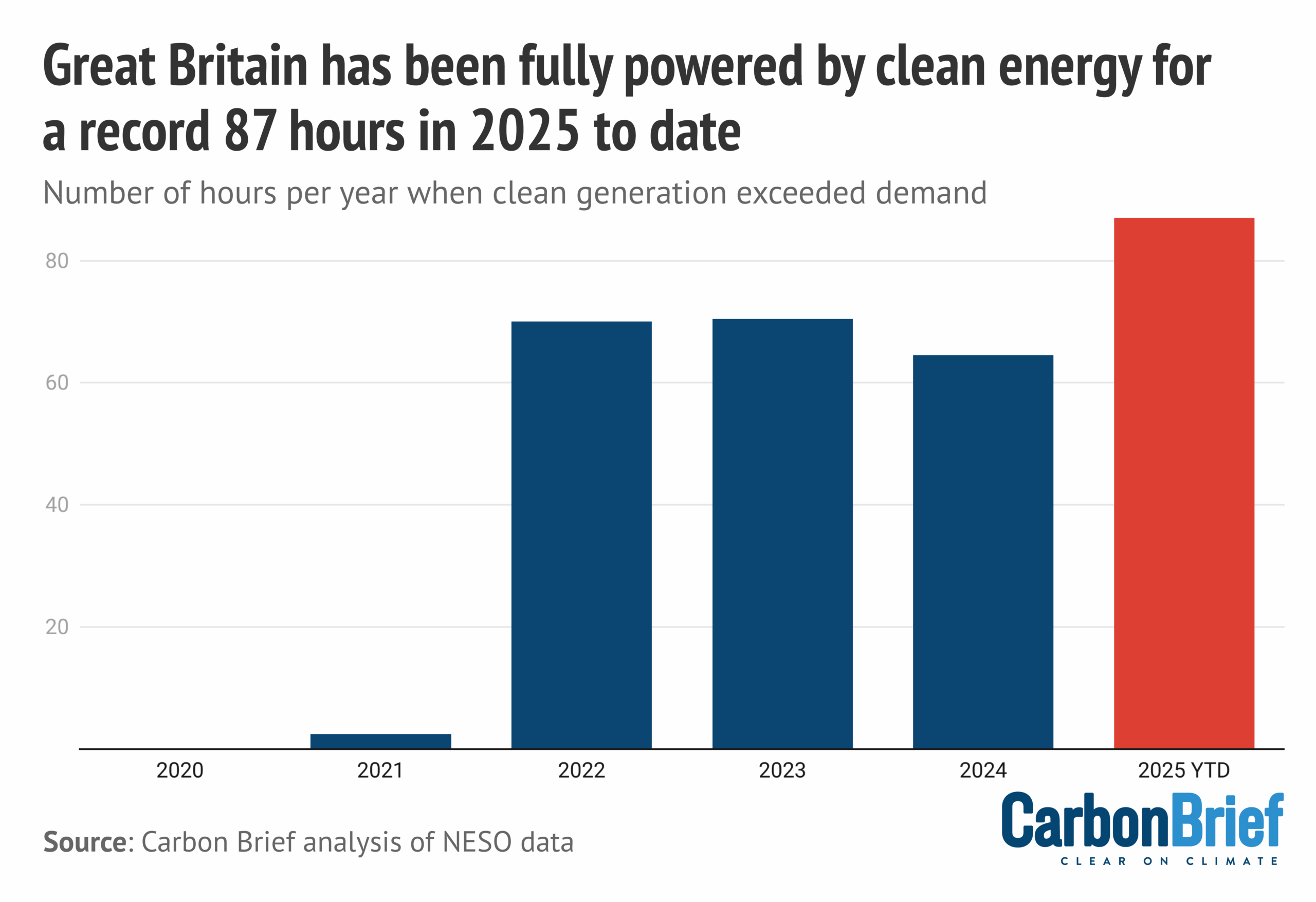
Clean energy has met 100% of Great Britain’s electricity demand for a record 87 hours this year so far, according to new Carbon Brief analysis. This is up from just 2.5 hours in 2021 and 64.5 hours in all of 2024. The longest stretch of time where 100% of electricity demand was met by clean energy stands at 15 hours, from midnight on 25 May 2025 through to 3pm on 26 May, according to the analysis.
Spotlight
‘Overshoot’ unknowns
As the chances of limiting global warming to 1.5C dwindle, there is increasing focus on the prospects for “overshooting” the Paris Agreement target and then bringing temperatures back down by removing CO2 from the atmosphere.
At the first-ever Overshoot Conference in Laxenburg, Austria, Carbon Brief asks experts about the key unknowns around warming “overshoot”.
Sir Prof Jim Skea
Chair of the Intergovernmental Panel on Climate Change (IPCC) and emeritus professor at Imperial College London’s Centre for Environmental Policy
So there are huge knowledge gaps around overshoot and carbon dioxide removal (CDR). As it’s very clear from the themes of this conference, we don’t altogether understand how the Earth would react in taking CO2 out of the atmosphere.
We don’t understand the nature of the irreversibilities and we don’t understand the effectiveness of CDR techniques, which might themselves be influenced by the level of global warming, plus all the equity and sustainability issues surrounding using CDR techniques.
Prof Kristie Ebi
Professor at the University of Washington’s Center for Health and the Global Environment
There are all kinds of questions about adaptation and how to approach effective adaptation. At the moment, adaptation is primarily assuming a continual increase in global mean surface temperature. If there is going to be a peak – and of course, we don’t know what that peak is – then how do you start planning? Do you change your planning?
There are places, for instance when thinking about hard infrastructure, [where overshoot] may result in a change in your plan – because as you come down the backside, maybe the need would be less. For example, when building a bridge taller. And when implementing early warning systems, how do you take into account that there will be a peak and ultimately a decline? There is almost no work in that. I would say that’s one of the critical unknowns.
Dr James Fletcher
Former minister for public service, sustainable development, energy, science and technology for Saint Lucia and negotiator at COP21 in Paris.
The key unknown is where we’re going to land. At what point will we peak [temperatures] before we start going down and how long will we stay in that overshoot period? That is a scary thing. Yes, there will be overshoot, but at what point will that overshoot peak? Are we peaking at 1.6C, 1.7C, 2.1C?
All of these are scary scenarios for small island developing states – anything above 1.5C is scary. Every fraction of a degree matters to us. Where we peak is very important and how long we stay in this overshoot period is equally important. That’s when you start getting into very serious, irreversible impacts and tipping points.
Prof Oliver Geden
Senior fellow and head of the climate policy and politics research cluster at the German Institute for International and Security Affairs and vice-chair of IPCC Working Group III
[A key unknown] is whether countries are really willing to commit to net-negative trajectories. We are assuming, in science, global pathways going net-negative, with hardly any country saying they want to go there. So maybe it is just an academic thought experiment. So we don’t know yet if [overshoot] is even relevant. It is relevant in the sense that if we do, [the] 1.5C [target] stays on the table. But I think the next phase needs to be that countries – or the UNFCCC as a whole – needs to decide what they want to do.
Prof Lavanya Rajamani
Professor of international environmental law at the University of Oxford
I think there are several scientific unknowns, but I would like to focus on the governance unknowns with respect to overshoot. To me, a key governance unknown is the extent to which our current legal and regulatory architecture – across levels of governance, so domestic, regional and international – will actually be responsive to the needs of an overshoot world and the consequences of actually not having regulatory and governance architectures in place to address overshoot.
Watch, read, listen
FUTURE GAZING: The Financial Times examined a “future where China wins the green race”.
‘JUNK CREDITS’: Climate Home News reported on a “forest carbon megaproject” in Zimbabwe that has allegedly “generated millions of junk credits”.
‘SINK OR SWIM’: An extract from a new book on how the world needs to adapt to climate change, by Dr Susannah Fisher, featured in Backchannel.
Coming up
- 7 October: International Energy Agency (IEA) renewables 2025 report launch
- 8-10 October: World summit of Indigenous peoples and nature, Abu Dhabi, UAE
- 9-15 October: International Union for the Conservation of Nature (IUCN) 2025 congress, Abu Dhabi, UAE
Pick of the jobs
- UK government foreign, commonwealth and development office, senior climate policy adviser | Salary: CA$93,207. Location: Calgary, Canada
- Wellcome Trust, senior research manager, climate and health | Salary: £64,800. Location: London
- Bloomberg, product manager – climate, nature and sustainability regulations | Salary: Unknown. Location: London
DeBriefed is edited by Daisy Dunne. Please send any tips or feedback to debriefed@carbonbrief.org.
This is an online version of Carbon Brief’s weekly DeBriefed email newsletter. Subscribe for free here.
The post DeBriefed 3 October 2025: UK political gap on climate widens; Fossil-fuelled Typhoon Ragasa; ‘Overshoot’ unknowns appeared first on Carbon Brief.
Greenhouse Gases
Q&A: What the ‘controversial’ GWP* methane metric means for farming emissions
A controversial way of measuring how much methane warms the planet has stirred debate in recent years – particularly around assessing the climate impact of livestock farming.
The metric – known as GWP* (global warming potential star) – was designed to more precisely account for the warming impact of short-lived greenhouse gases, such as methane.
No country so far has used GWP* to measure emissions, but New Zealand is currently considering its use.
In June, a group of climate scientists from around the world wrote an open letter advising against this.
They argued that the metric “creates the expectation that current high levels of methane emissions are allowed to continue”.
Climate experts tell Carbon Brief that there is “no strong debate” on the science behind GWP* and that it can accurately assess the global warming effect of methane.
But many experts also firmly caution against its use in national climate targets, believing it could allow countries to prolong high levels of emissions at a time when they should be drastically cut.
Some researchers tell Carbon Brief that GWP* is an “accounting trick” and a “get-out-of-jail-free card for methane emitters”. A 2021 Bloomberg article called the metric “fuzzy methane math”.
Prof Myles Allen, one of the scientists who created GWP*, tells Carbon Brief that the metric is “nothing more” than one way of better understanding the climate impact of different actions as part of efforts to limit warming under the Paris Agreement.
In this Q&A, Carbon Brief explains the science behind GWP*, why the metric is so divisive and the ways in which its use has been considered.
- What is GWP*?
- What are the main controversies around using GWP*?
- Do any countries currently use GWP* to measure methane emissions?
- What do experts think about the use of GWP*?
What is GWP*?
Global warming is caused by a build up of greenhouse gases – mainly from burning fossil fuels – trapping heat in the atmosphere.
Different gases cause differing levels of warming and remain in the atmosphere for varying lengths of time. For example, carbon dioxide (CO2), the main contributor to warming, lingers for centuries, whereas other gases last decades or even millennia.
To account for these variables, scientists use a metric known as global warming potential (GWP), which assesses the warming caused by different gases compared to CO2, which has a GWP of 1.
Using GWP, emissions of other gases are calculated in terms of their “CO2 equivalent” over a given amount of time.
In their reports, the Intergovernmental Panel on Climate Change (IPCC) set out three GWP variants measured over 20 years (GWP20), 100 years (GWP100) and 500 years (GWP500).
GWP100 is the most common approach and is used to calculate emissions under the Paris Agreement.
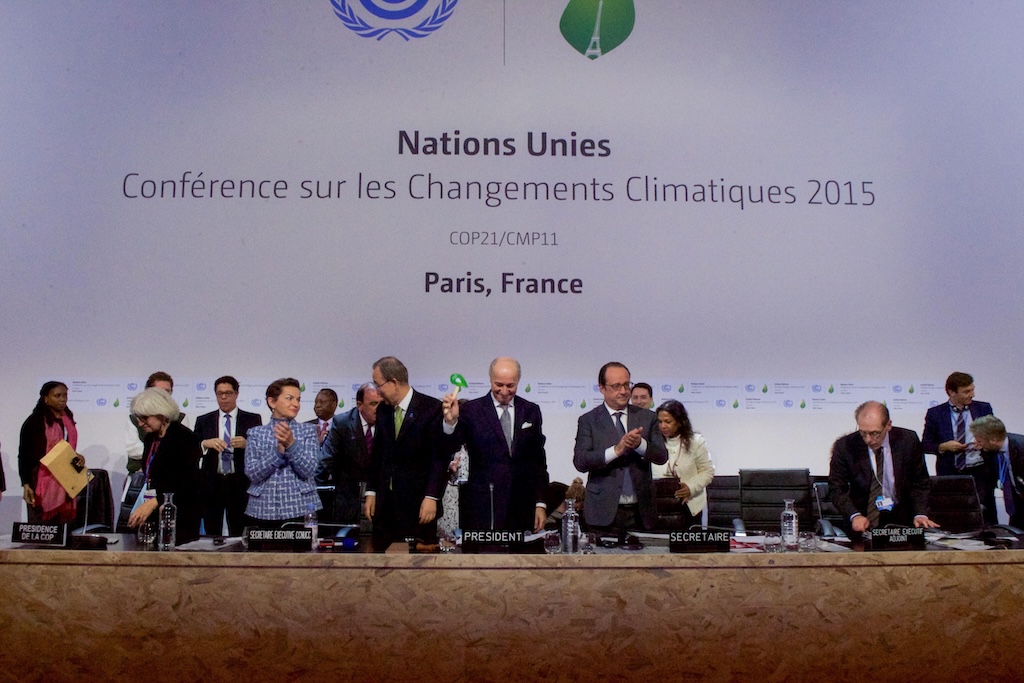
Methane is a short-lived gas that only remains in the atmosphere for around 12 years before breaking down. But it causes a large burst of initial warming that is around 80 times more powerful than CO2, according to the IPCC.
This means that one tonne of methane causes the same amount of warming as around 80 tonnes of CO2, when measured over a period of 20 years.
When calculated over 100 years, methane’s shorter lifetime means it causes around 30 times more warming than CO2.
Some experts have criticised the use of GWP100, saying it does not sufficiently account for the fact that methane leaves the atmosphere much more quickly than CO2 and does not actually last for 100 years. This is the issue that GWP* was designed to fix.
GWP* calculates the warming contributions of long- and short-lived gases at different rates, accounting for their varying lifetimes in the atmosphere.
One of the researchers behind GWP*, Dr Michelle Cain, explained in a 2018 Carbon Brief guest post that a constant rate of methane emissions can maintain stable atmospheric concentrations of the gas, assuming methane sinks remain constant as well.
In contrast, a constant rate of CO2 emissions “leads to year-on-year increases in warming, because the CO2 accumulates in the atmosphere”, Cain wrote. CO2 does not leave the atmosphere after a decade or so, as methane does, and continues to build over time until emissions stop.
Cain, formerly a researcher at the University of Oxford and now a senior lecturer at Cranfield University, added:
“For countries with high methane emissions – due to, say, agriculture – this can make a huge difference to how their progress in emission reductions is judged.”
Methane emissions that slowly decline or remain stable over time are calculated as contributing “no additional warming” to the planet, which is not the case with other GWP calculations.
The chart below shows simplified emissions scenarios for CO2 and methane, highlighting the different impacts they have on global warming over time.
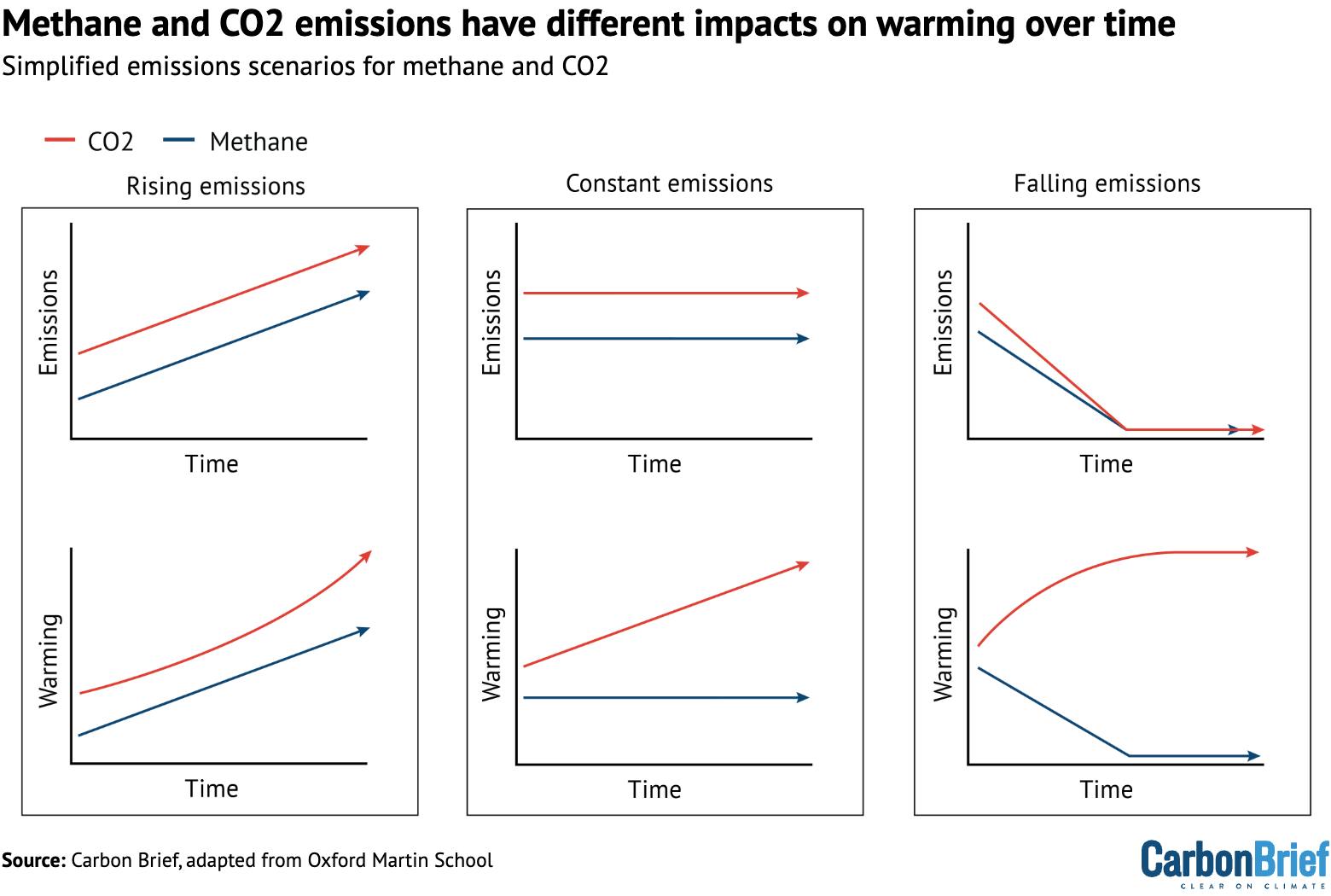
The chart below shows how using the two different metrics – GWP* and GWP100 – affects the same emissions pathway throughout the 21st century, given the different warming impacts of greenhouse gases.

If, for example, a country emitted 4m tonnes of methane annually from 1990-2005, these emissions would now be considered “climate-neutral” using GWP*, as they are not actively contributing new warming to the atmosphere, but rather maintaining the existing levels of methane in the atmosphere in 1990.
This would not be the case under GWP100, which looks at the warming potential of emissions over the course of a century and does not account for their different atmospheric lifetimes.
GWP* can be used for other short-lived gases, such as some hydrofluorocarbons, but methane is the most significant short-lived gas when it comes to climate change.
The IPCC notes that converting methane emissions into CO2 equivalent using GWP100 “overstates the effect of constant methane emissions on global surface temperature by a factor of 3-4” and understates the impact of new methane emissions “by a factor of 4-5 over the 20 years following the introduction of the new source”.
GWP* was created by several researchers, including Prof Myles Allen, the head of atmospheric, oceanic and planetary physics at the University of Oxford. The concept was detailed in a 2016 study and first named in a 2018 study. It was further updated by the authors in 2019 and 2020.
Allen tells Carbon Brief that the researchers involved were “reluctant” to give their new metric a name, as it “was just a way of using reported numbers to calculate warming impact”. He adds:
“I think it’s really unfortunate that people have latched onto GWP*. It doesn’t matter. We could forget about GWP* entirely, we can just use a climate model to work out the warming impact…GWP* is a handy way of calculating the warming impact of activities. Nothing more.”
What are the main controversies around using GWP*?
Efforts to cut methane emissions are widely viewed as a “quick-win” to help limit the effects of climate change in the short term.
More than 100 countries signed a pledge, launched at COP26 in 2021, to cut global methane emissions by 30% by 2030.
Cutting methane would also help to counteract an acceleration in warming due to declining aerosol emissions, which are currently masking around half a degree of warming.
Experts Carbon Brief spoke to agree on the importance of cutting methane emissions, but disagree on whether GWP* helps or hinders these efforts.
The debate around the metric centres on the possible impacts of its use, rather than the soundness of the science behind it.
Prof Joeri Rogelj, a climate science and policy professor at Imperial College London, explains:
“At the global level, at any level, the method of GWP* actually provides a good, new way to translate the trajectory of methane emissions into equivalent emissions of CO2, or emissions of CO2 that would have an equivalent warming effect…The debate is on the application.”
Allen says he is a “little frustrated” that discussions around the use of GWP* have “become so emotive”. He tells Carbon Brief:
“Every action we take has both a temporary impact on global temperature and a permanent one. How much is in both areas depends on the action. We need to know those two things in order to make decisions about choices of action in pursuit of a temperature goal…GWP* gives you a handy way of doing that.”
Below, Carbon Brief details some of the main discussion points and controversies around GWP*.
Carbon cycle
A misleading claim frequently made about livestock is that cows do not contribute much to global warming because the methane they emit eventually returns to the land through the carbon cycle – the set of processes in which carbon is exchanged between the atmosphere, land and ocean, as well as the organisms they contain.
Those in favour of using GWP* to measure methane emissions often also stress the difference between methane emissions that come from animals – known as biogenic methane – and methane from fossil fuels.
Rogelj tells Carbon Brief that biogenic and fossil-sourced methane are “slightly different, but that difference is really second-order” when it comes to climate change.
Methane warms the planet while it is in the atmosphere, so the “climate effect is exactly the same, irrespective of which source the methane comes from”, Rogelj adds.
The differences become more significant when methane breaks down in the atmosphere and oxidises into water vapour and CO2.
CO2 that originated from a cow can be reabsorbed by plants and the land. But the CO2 resulting from fossil methane – which stems from sources such as flaring from oil and gas drilling – stays in the atmosphere. Although fossil methane has a “bit of a longer effect”, Rogelj says:
“This is a bit of a red herring, because the main effect is, of course, the effect that the methane has while it is methane and not what the carbon molecule of that methane has after [the] methane has been broken down or oxidised to CO2.”
He adds that there are ways of reducing agricultural methane, such as “diet change” or “management measures”, but no way to remove the emissions “100%”.
The graphic below shows the digestive process through which a cow emits methane.
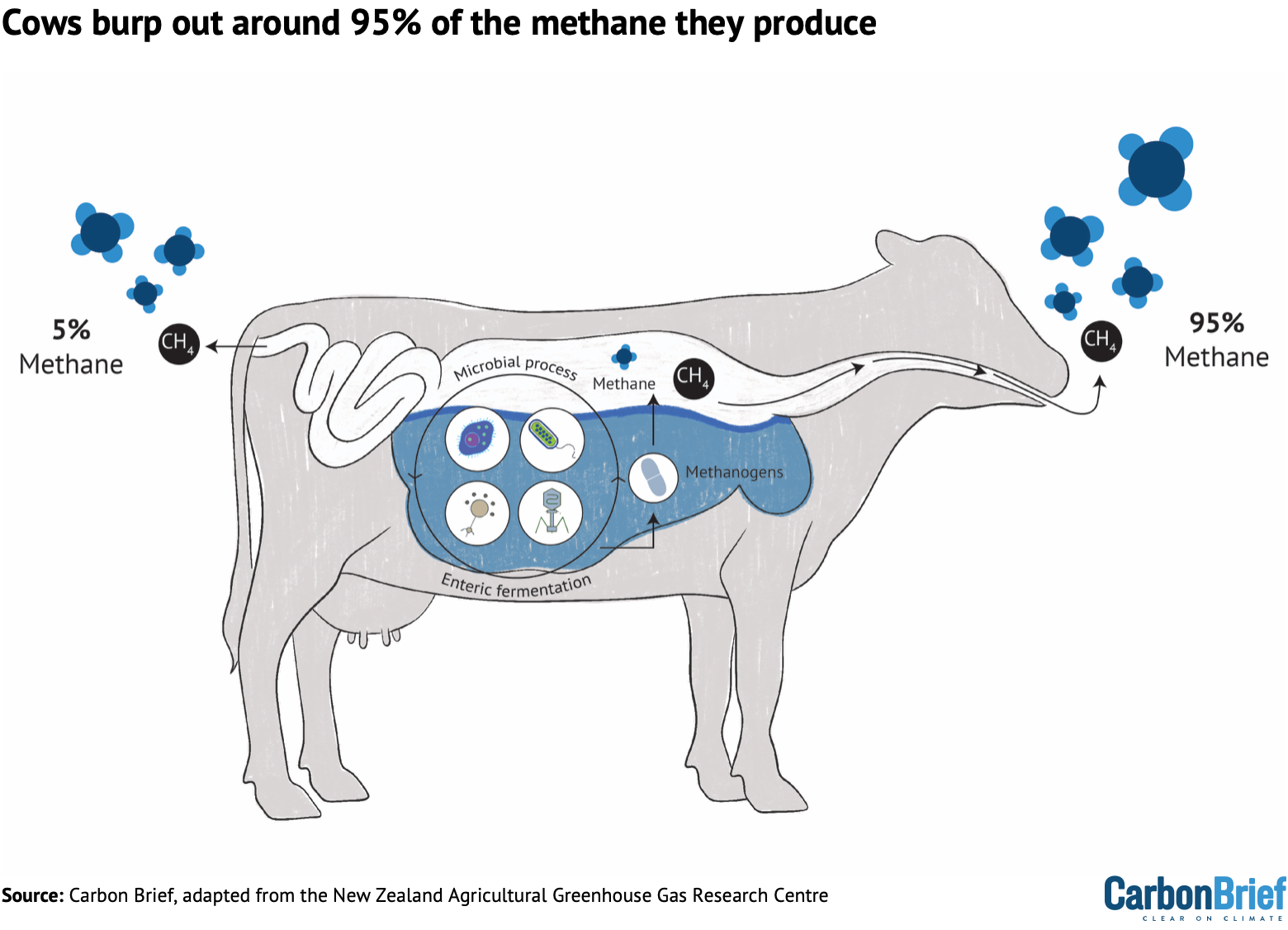
Agriculture also causes other significant environmental harms. It is responsible for around 80% of global deforestation and is a key driver of biodiversity loss and water pollution.
Prof Frank Mitloehner, a professor and air-quality specialist at the University of California, Davis (UC Davis), is one of the main proponents of GWP*, frequently speaking about it in public presentations and discussions with the farming sector.
He tells Carbon Brief that, while animal agriculture can cause environmental harm, it is a “silly argument” to say these impacts are being ignored in carbon-cycle discussions.
He gives an example of discussions on deaths from car accidents excluding mentions of the emissions from cars, saying that these wider impacts are still important and can be discussed separately.
He adds that it is an “urban myth” that biogenic methane emissions are not a concern because of the carbon cycle.
‘No additional warming’
Under GWP*, methane emissions stop causing new warming once they reduce by 10% over the course of 30 years – around 3% each decade, or 0.3% each year.
These emissions are then described in research and policy as causing “no additional warming”.
For example, a 2021 study from Mitloehner and other UC Davis researchers, found that methane emissions from the US cattle industry “have not contributed additional warming since 1986”, based on GWP* calculations. It also said that the dairy industry in California “will approach climate neutrality” by the 2030s, if methane emissions are cut by just 1% annually.
(According to the US Environmental Protection Agency, methane emissions from enteric fermentation – the digestive process through which cows produce the greenhouse gas – increased by more than 5% over 1990-2022.)
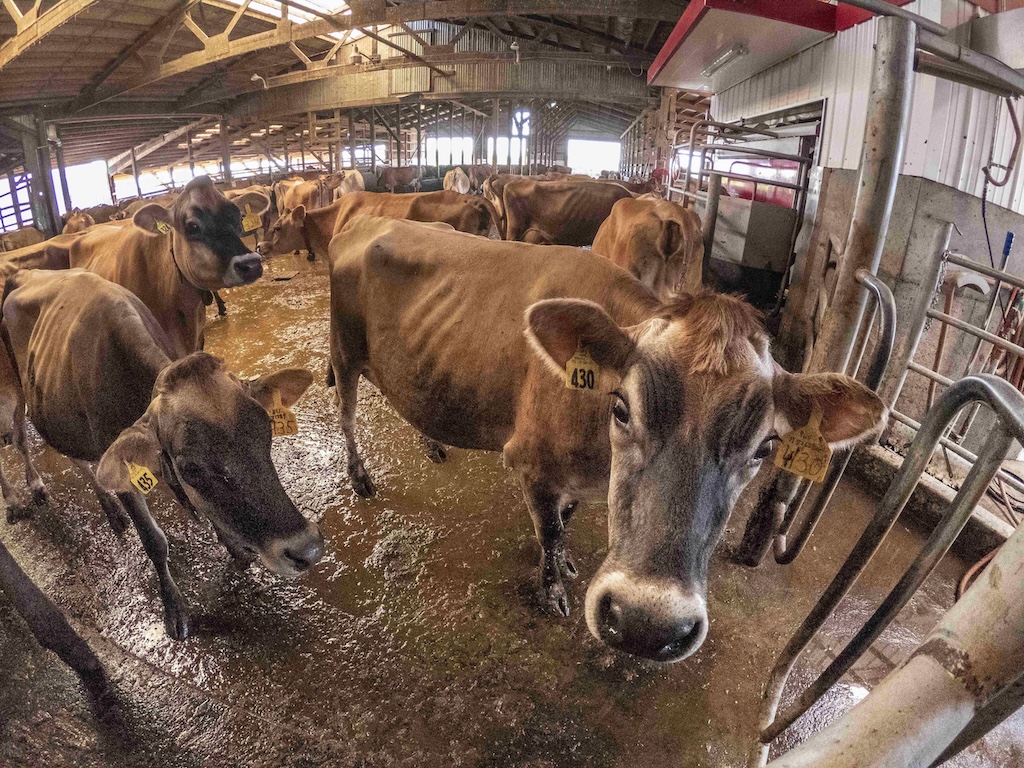
However, many critics take issue with the “no additional warming” concept.
The main criticism is that, although a gradually reducing herd of cattle may stabilise methane emissions, it still emits the polluting gas. If animal numbers were instead drastically reduced, this would cut methane emissions and lower warming rather than maintaining current levels.
Dr Caspar Donnison, a postdoctoral researcher at Lawrence Livermore National Laboratory in the US, says the term no additional warming is “absolutely misleading” in the context of GWP*. He tells Carbon Brief:
“You just assume, on the face of it, that this means it has a neutral impact on the climate…But ‘no additional warming’ means that you’re still sustaining the warming that the herd is causing.”
Allen says that the debate focuses on the “stock of warming versus additional warming”. He compares it to accounting for historical emissions of CO2:
“If a country got rich by burning CO2, they’ve caused a lot of warming in the past. If they reduce their CO2 emissions to zero, then people are generally happy to call what they’re doing climate-neutral, even though they may be sitting on a huge heap of historical warming caused by their CO2 emissions while they were burning [fossil fuels].
“And yet, temperature-wise, that’s exactly the same thing as having a source of methane that’s declining by 3% per decade.”
Climate ambition
Another criticism around the use of GWP* is that countries or companies with high agricultural methane emissions could use the metric to make small emission reductions appear larger.
Dr Donal Murphy-Bokern, an independent agricultural and environmental scientist, believes that the metric can be used as a “get-out-of-jail-free card for methane emitters”. He adds:
“It’s all about saying carry on as we are; we’ll manage this by slightly reducing our emissions over a critical period in history, so as to appear at that critical period in history to be so-called ‘climate-neutral’.”
Mitloehner disagrees with this, noting that, while reductions in methane emissions appear significant under GWP*, increases also appear significant. He says:
“It is simply not true that GWP* is a get-out-of-jail-free card. It’s not. If you reduce emissions, it makes your contributions look less. If you increase emissions, it makes your contributions much worse.”
Rogelj says he has not seen GWP* being used to advocate for the “highest possible ambition” in cutting methane emissions.
However, Allen says that “no metric tells you what to do”. He adds:
“How you measure emissions and how you measure warming has absolutely no bearing on whether you think a country has an obligation to undo some of the damage to the climate they’ve caused in the past.
“This is where the ‘free-pass’ argument makes no sense to me, because the existence of a method to calculate the warming impact of your emissions allows you to make decisions about emissions in light of their warming impact, sure, but it doesn’t tell you what the outcomes of those decisions should be.”
Allen adds that the livestock sector is “unsustainable globally”, with animal numbers and methane levels still rising.
The chart below shows how atmospheric methane concentrations have increased in recent decades.

Allen tells Carbon Brief:
“Do we need to eliminate livestock agriculture to stop global warming? No…[but] we do need to start decreasing it. And if we can decrease it faster than 3% per decade then that would help reduce warming that’s caused by other sectors or, indeed, undo some of the warming that the livestock sector has caused in the past.”
Mitloehner says considerations on the fairness of using GWP* are “real from a policy standpoint and they have to be addressed from a policy standpoint”. He adds:
“But, from a scientific standpoint – and that’s where I’m coming from – I think it’s not controversial.”
Baseline and historical emissions
The baseline year from which emissions reduction targets are set is significant, as it helps form the scope of climate ambition.
For example, high-emitting countries, such as the UK, have set 1990 as their baseline year for emissions-cutting targets, whereas many low-emitting countries may choose further back or more recent years, depending on their needs. Rogelj says:
“Because GWP* translates a change in emissions into either an instantaneous emission or instantaneous removal of CO2, your starting point becomes really important.
“If you start with very high emissions of methane and you did not in any way account for this high starting point, then even very minor, unambitious reductions in methane would result in creating credits for high-polluting countries.”
However, he notes that this is just one way of applying the metric and that there could be ways to avoid this “inequitable outcome”, such as applying GWP* globally and allocating each country a per-capita methane budget, instead of assessing based on national current or past emissions. (Rogelj and Prof Carl-Friedrich Schleussner discussed other possible GWP* equity measures in a 2019 study.)
The chart below, adapted from that study, shows how GWP* can significantly change the per-capita methane emissions of different countries. Some countries with high agricultural methane emissions, such as New Zealand, change from high to low per-capita emitters.
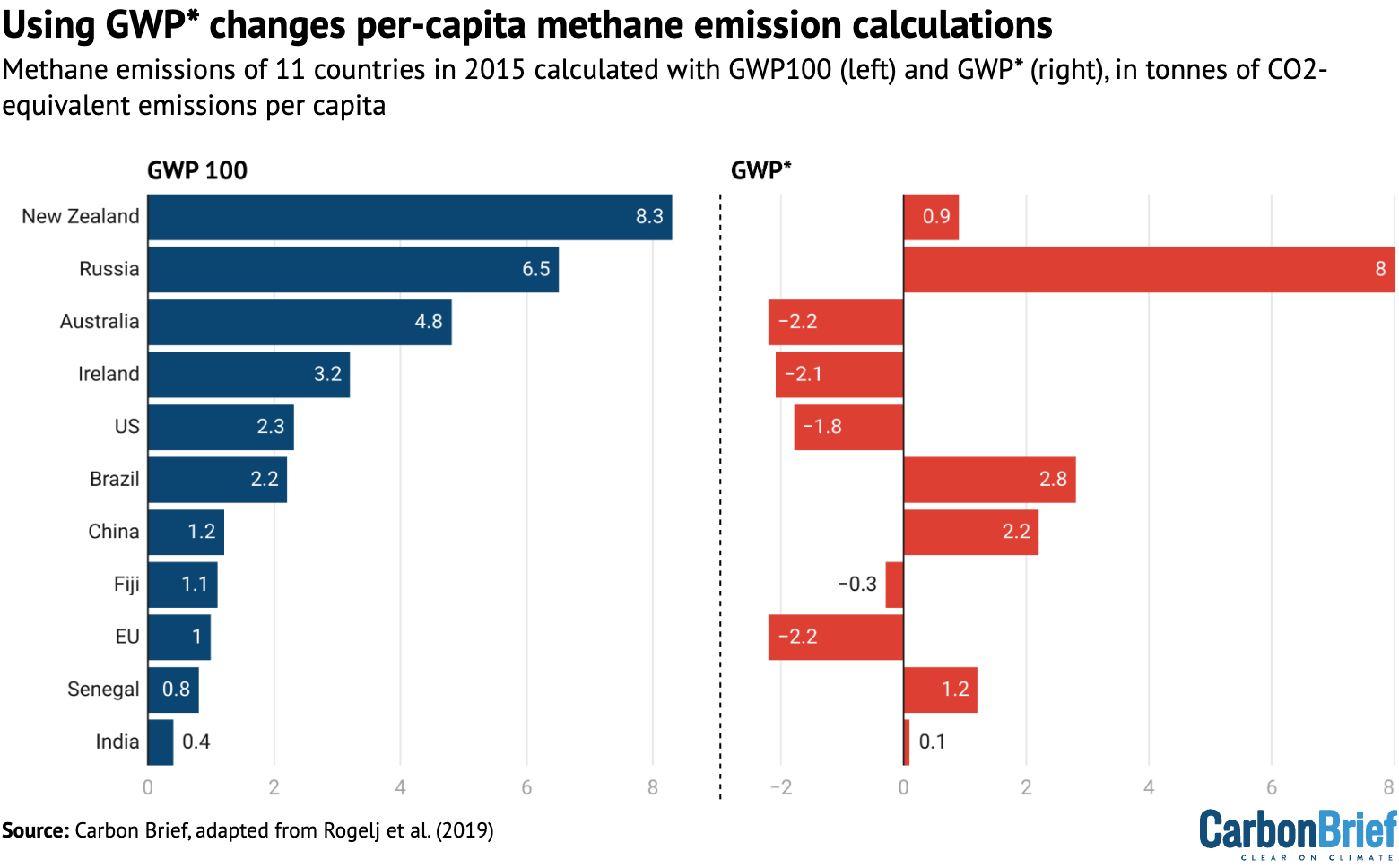
A 2025 study used a climate model to quantify future national warming contributions for Ireland under different emissions scenarios and found that “no additional warming” approaches, such as GWP*, are “not a robust basis for fair and effective national climate policy”.
Discussing baseline concerns, Allen says these considerations are the same for any other metric:
“It depends on how much account you want to take of [the] warming you’ve caused in the past – and at what point you want to take responsibility for the warming your actions had caused.”
He believes that most climate experts agree that it is good to understand the impact emissions have on global temperatures, but “where the controversy arises is about what you consider someone’s nominal emissions to be today”. He adds:
“This is where everybody gets upset, because if you use GWP*, then a livestock sector that’s reducing its emissions by 3% per decade – which most global-north livestock sectors are doing – it looks like their emissions are quite small.
“But that’s only a problem if you think that the main issue is working out whose fault global warming is, rather than working out what we should do about it.”
Communication
Many experts Carbon Brief spoke to took issue with how GWP* has been discussed by some of its proponents.
Murphy-Bokern criticises how Mitloehner and other experts communicate the metric. He says:
“The confusion arises from the activities of Mitloehner, in particular, where he presents the farming community – and the industry in general – with the idea that you can magic away the warming effect of methane simply by looking at the rate of change of methane emissions.”
Mitloehner says he has no regrets about his communication of GWP*, adding that he has “always emphasised to the livestock sector that reductions of methane are important”. He tells Carbon Brief:
“I’m proud because I have been able to take the livestock sector along with the understanding that reductions are needed and that they can be part of a solution if they understand that.”
The New York Times reported in 2022 that the research centre led by Mitloehner at the University of California, Davis “receives almost all its funding from industry donations and coordinates with a major livestock lobby group on messaging campaigns”. Other reports note his discussions about GWP* with stakeholders in various countries.
In response to these reports, Mitloehner says he believes it is important to work with the sector you are researching, adding that he receives both public and private funding. He tells Carbon Brief:
“The problem is not that they [the meat industry] are investing in research and communications and extension. The problem is that they are not putting in enough, because the public sector is withdrawing from this.
“Climate research is being slashed…If the government is not paying into research to quantify and reduce emissions – and those people who are critical of what we do say ‘oh, industry shouldn’t do it’ – then, I ask you, who should?”
Colin Woodall, the chief executive of the National Cattlemen’s Beef Association, a US lobby group, said in 2022 that GWP* is the “methodology we need to make sure everybody is utilising in order to tell the true story of methane”, Unearthed reported. According to the outlet, he added:
“We’re working with our partners around the globe to ensure that everybody is working towards adoption of GWP*.”
Asked if he regrets anything about his communication of GWP*, Allen tells Carbon Brief:
“When we first introduced this – and, perhaps, this is one thing I do regret – I was, perhaps, a little naive in that I thought everybody would seize on focusing on [the] warming impact because it was, from a policy perspective, potentially much easier for the agricultural sector.
“I thought that this would actually be welcomed. But, sadly, it’s not been. And I think part of that is because of this narrative of blame.”
Do any countries currently use GWP* to measure methane emissions?
GWP* is not yet used by any country in methane emission reporting or targets. But it has been considered by New Zealand, Ireland and other nations with high agricultural emissions.
A 2024 statement from dozens of NGOs and environmental organisations called for countries and companies not to use GWP* in their greenhouse gas reporting or to guide their climate mitigation policies. They wrote:
“The risks of GWP* significantly outweigh the benefits.”
New Zealand
New Zealand is currently considering changing its biogenic methane target, including applying the “no additional warming” approach used in GWP*. If it does so, it could become the first country to adopt GWP*.
The nation is a major livestock producer and agriculture generates nearly half of all its greenhouse gas emissions.
The chart below shows that the agricultural sector is also responsible for more than 90% of the country’s methane emissions.
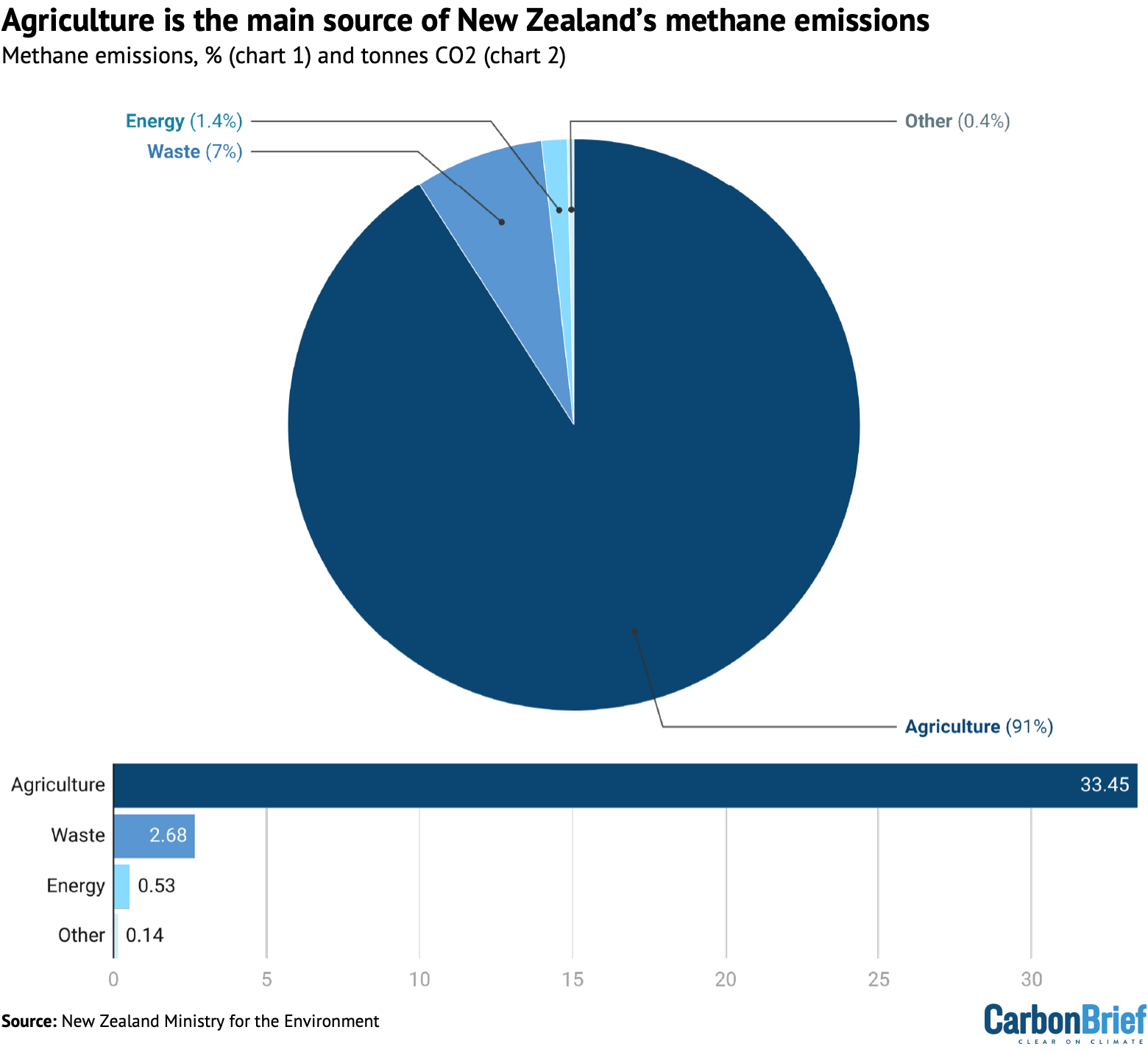
New Zealand has a legally binding target to reach net-zero greenhouse gas emissions by 2050. However, biogenic methane has separate targets to reduce by 10% by 2030 and by 24-47% by 2050, compared to a baseline of 2017 levels.
In late 2024, a review from the nation’s Climate Change Commission recommended that the government change its 2050 greenhouse gas targets, including to increase the biogenic methane goal to a 35-47% reduction by 2050.
At the same time, an independent panel commissioned by the New Zealand government reviewed how the country’s climate targets would look under the “no additional warming” approach.
The resulting report, which did not look specifically at GWP*, but used a similar concept, found that a 14-15% cut in biogenic methane by 2050 would be “consistent with meeting the ‘no additional warming’ condition”, under mid-range global emissions scenarios that keep temperatures below 2C.
The government is “currently considering” these findings, a spokesperson for the Ministry for the Environment tells Carbon Brief in a statement.
The spokesperson says that the report is “part of the body of evidence” that the government will use in its response to the Climate Change Commission’s review, which it must publish by November 2025.

Cain, the Cranfield University lecturer who co-created GWP*, wrote in Climate Home News in 2019 that New Zealand reducing biogenic methane by 24% would “offset the warming impact” of the rest of the country’s emissions, adding:
“New Zealand could declare itself climate-neutral almost immediately, well before 2050 and only because farmers were reducing their methane emissions. That’s a free pass to all the other sectors, courtesy of New Zealand’s farmers.”
A report on GWP* by the Changing Markets Foundation found that, in 2020, 16 industry groups in New Zealand and the UK “urged” the UN’s Intergovernmental Panel on Climate Change to use GWP* to assess warming impacts.
Australia
The Guardian reported in May 2024 that Cattle Australia, a cattle producer trade group, was “lobbying the red-meat sector to ditch its net-zero target in favour of a ‘climate-neutral’ goal that would require far more modest reductions in methane emissions”.
Cattle Australia’s senior adviser and former chief executive, Dr Chris Parker, tells Carbon Brief in a statement that the organisation is “working with the Australian government to ensure methane emissions within the biogenic carbon cycle are appropriately accounted for in our national accounting systems”. He adds:
“We believe GWP* offers a more accurate way of assessing methane’s temporary place in the atmosphere and its impact on the climate. Australian cattle producers are part of the climate solution and we need policy settings to enable them to participate in carbon markets.”
Australia’s Department of Climate Change, Energy, the Environment and Water did not respond to Carbon Brief’s request for comment.
Ireland
Internal documents assessed for the Changing Markets Foundation’s GWP* report “suggest” that Ireland’s Department of Agriculture, Food and the Marine has advocated for GWP* “at the international level”, including at the UN’s COP26 climate summit in 2021.
Allen and Mitloehner were involved in a 2022 Irish parliamentary discussion on methane, in which Allen advocated for the country to “be a policy pioneer” by using GWP* in its methane reporting alongside standard methods.
The country’s coalition government, formed earlier this year, pledged to “recognise the distinct characteristics of biogenic methane” and also “advocate for the accounting of this greenhouse gas to be re-classified at EU and international level”.
A spokesperson for Ireland’s Department of Agriculture, Food and the Marine tells Carbon Brief that this does not refer to using GWP* specifically. They say the country is “in favour of using accurate, scientifically validated and internationally accepted emission measurement metrics”, adding:
“It is important that the nature of how biogenic methane interacts in the environment is accurately reflected in how it is accounted for. This does not mean the use of the metric GWP*.”
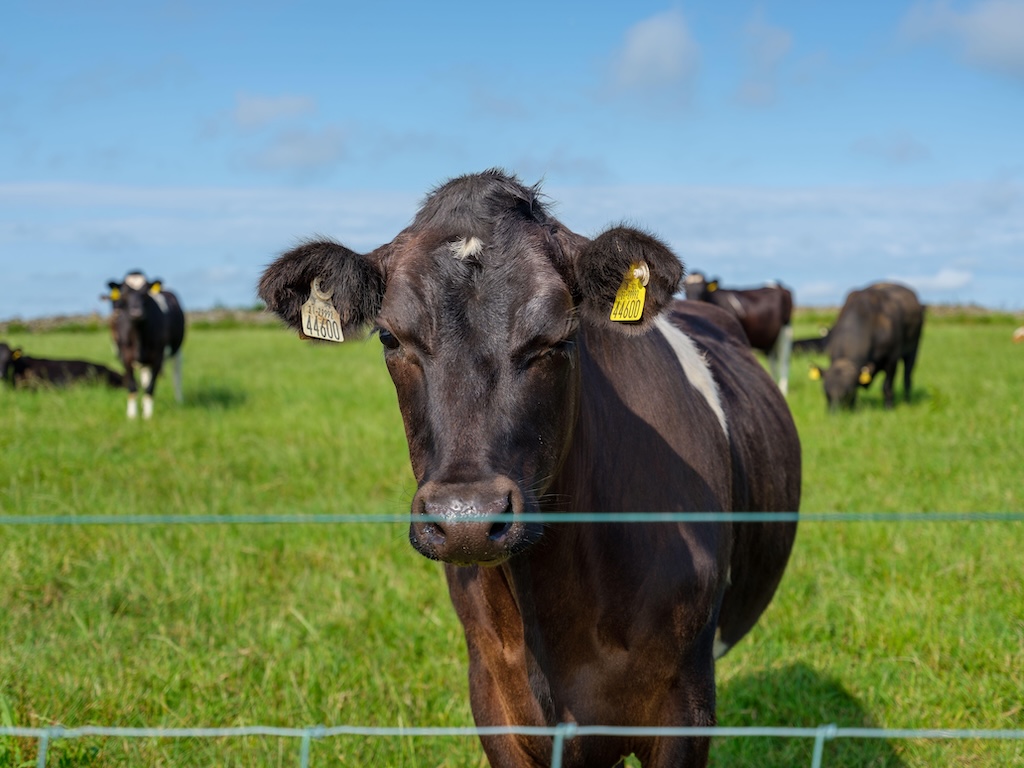
In December 2024, Ireland’s Climate Change Advisory Council proposed temperature neutrality pathway options to the government that do not specifically refer to GWP*, but use the same concept of no “additional warming”.
The Irish Times reported that this was “in part to reduce potential disruption from Ireland’s legal commitment to achieve national ‘climate neutrality’ by 2050”.
The climate and energy minister, Darragh O’Brien, said he has “not formed a definitive view” on this, the newspaper noted, and that expert views will feed into ongoing discussions on the 2031-40 carbon budgets, which are due to be finalised later in 2025.
In an Irish Times opinion article, Prof Hannah Daly from University College Cork, described the temperature neutrality consideration as “one of the most consequential climate decisions this government will make”. She wrote that the approach “amounts to a free pass for continued high emissions” of livestock methane.
Paraguay
Paraguay mentioned GWP* in a national submission to the UN in 2023 after agribusiness representatives “pushed” to adopt the metric, according to Consenso, a Paraguayan online newsletter.
The country’s National Directorate of Climate Change told Consenso for a separate article related to GWP* that it is “aware” of questions around the metric, but that it “has the option of using other measurement systems” for emissions reporting.
UK
The National Farmers’ Union, the main farming representative group in England and Wales, is in favour of using GWP* to measure agricultural methane emissions.
Carbon Brief understands that the UK government is not currently considering using GWP* in addition to, or instead of, GWP100 in its emissions reporting.
What do experts think about the use of GWP*?
Most experts Carbon Brief spoke to agreed that GWP* could be a useful metric to apply to global methane emissions, but that it is difficult to apply equitably in individual countries or sectors. Rogelj believes that are are some contexts in which GWP* could be used, but adds:
“You cannot just take targets that were set and discussed historically with one greenhouse gas metric in mind – GWP100 under the UNFCCC [United Nations Framework on Climate Change] and the Paris Agreement and all that – [and] then simply apply a different metric to it. They change meaning entirely.
“So, if one would like to use GWP*, one should build the policy targets and frameworks from the ground up to take advantage of the strengths of that metric, but also put in place safeguards that ensure that the weaknesses and limitations of that metric do not result in unfair or undesirable outcomes.”
A 2022 study says that using GWP* in climate plans “would ask countries to start from scratch in terms of their political target setting processes”, calling it a “bold ask” for policymakers.
It adds that achieving net-zero emissions, as measured with GWP*, “would only lead to a stabilisation of temperatures at their peak level”.
However, a 2024 study found that GWP* gives a “dynamic” assessment of the warming impact of emissions that “better aligns with temperature goals” than GWP100, when measuring methane emissions from agriculture.
Allen believes that criticism over the use of GWP* is similar to “saying it’s a meaningless question” to consider the warming impact of a country or company’s actions. He adds:
“That seems a very strange position to me, because we need to know how different activities are contributing to global warming because we have a temperature target.
“In saying GWP* is a bad thing, what people are actually saying is it’s a bad thing to know the warming impact of our actions, which is a very strange thing to say.”
He says that such metrics help countries to make informed decisions on climate action, but that “we can’t expect metrics to make these decisions for us”.
Murphy-Bokern notes that GWP* could be useful in modelling global, rather than national, methane emissions to avoid high-emitting countries making small methane cuts to achieve “no additional warming”, rather than significantly reducing these emissions.
He says the metric would be particularly useful if global emissions were close to zero, as a way to target the final remaining emissions. But, he adds:
“We are so far away from that very happy situation, that the discussion now with GWP* is a huge distraction from the key objective, which is to reduce emissions.”
Mitloehner – and every expert Carbon Brief spoke with – agrees with this wider point. He says:
“The main point is we need to reduce emissions. In the case of livestock, we need to reduce methane emissions. And the question is how do we get it done? And how do we quantify the impacts that [that reduction] would have accurately and fairly? The other issues are issues that politicians have to answer.”
The post Q&A: What the ‘controversial’ GWP* methane metric means for farming emissions appeared first on Carbon Brief.
Q&A: What the ‘controversial’ GWP* methane metric means for farming emissions
Greenhouse Gases
EAT-Lancet report: Three key takeaways on climate and diet change
A global shift towards “healthier” diets could cut non-CO2 greenhouse gas emissions, such as methane, from agriculture by 15% by 2050, according to a new report.
The EAT-Lancet Commission report on “healthy, sustainable and just food systems” says this diet would require producing more fruit, vegetables and nuts, as well as fewer livestock.
The findings build on the widely cited 2019 report from the EAT-Lancet Commission – a group of leading experts in nutrition, climate, economics, health, social sciences and agriculture from around the world.
The new report notes that one-third of all greenhouse gas emissions come from the global food system.
These emissions are so great that, even if all fossil fuels were phased out, “food can on its own push us beyond the 1.5C limit”, one of the commission co-chairs, Prof Johan Rockström, told a press briefing.
The report details a “planetary health diet” – a concept first introduced in the 2019 report – which focuses on “plant-rich” and “minimally processed” foods.
The latest edition builds on the previous report by adding improved modelling of food-system transformation and adding social-justice considerations.
The 2019 report faced a “massive online backlash” against some of its findings, particularly on cutting meat consumption, DeSmog reported earlier this year, which was “stoked by a PR firm that represents the meat and dairy sector”.
Rockström said the commission is “ready to meet that assault” if it arises again and issued concern “over this return of mis- and disinformation and denialism on climate science”.
Here, Carbon Brief picks out three key takeaways from the latest report.
- A ‘plant-rich’ diet has the best health and climate outcomes
- Transforming food systems could ‘substantially reduce’ the associated emissions
- Social justice should be a ‘central goal’ in transforming global food systems
A ‘plant-rich’ diet has the best health and climate outcomes
The new report recommends a plant-rich “planetary health diet”, which is largely the same as the one first outlined in the 2019 report.
The diet is designed to be flexible and “compatible with many foods, cultures, dietary patterns, traditions and individual preferences”, the report says.
It does not exclude meat or dairy products – the foods that cause the highest emissions – but recommends limited portions, equating to around one glass of milk per day and a couple of servings of meat and two eggs each week, for those whose diets include them.
The chart below outlines the recommended intake of different foods, adding up to around 2,400 calories each day. A range is given for each food type to accommodate different diets. The categories with the largest intakes include whole grains, plant oils, nuts and legumes.

The diet is “designed for health…[not] sustainability”, Dr Line Gordon, a commissioner on the report, told a press briefing.
But the report also analyses the climate impact of the recommendations. It estimates that shifting to the planetary diet could reduce global non-CO2 agricultural emissions – from greenhouse gases such as methane and nitrous oxide – by 15% by 2050. (See: Transforming food systems could ‘substantially reduce’ the associated emissions.)
Widespread adoption of the diet would require a two-thirds increase in fruit, vegetable and nut production and allow for a one-third reduction in livestock meat production, compared to 2020 levels.
Currently, diets across the globe all “deviate substantially” from the report’s recommendations. But the report claims that, due to the planetary diet’s health benefits, around 15 million “avoidable” deaths could be prevented each year if it were widely adopted.
The report also measures how much global food systems contribute to the nine planetary boundaries – a concept of global thresholds for a “safe and just” planet. It finds that food systems are the largest contributor to five breaches of these boundaries, which include changes in the use of land and freshwater.
In terms of steps to move towards the planetary diet, Gordon listed actions such as changing taxes to make healthy foods more affordable, clearly labelling foods and shifting agricultural production subsidies towards healthier foods.
The report highlights that “transforming food systems is not only possible, it’s essential to securing a safe, just and sustainable future for all”, Rockström says in a statement.
Transforming food systems could ‘substantially reduce’ the associated emissions
Food systems are responsible for about one-third of human-driven greenhouse gas emissions.
These emissions are roughly equally partitioned between livestock and crop production, land-use change and other aspects of the food system, including refrigeration, fertilisers, transport and retail, according to the report.
The authors use global economic models to determine how different actions towards transforming food systems could affect agricultural production, environmental impact and food prices.
For the baseline, they use a set of “business-as-usual” parameters. This scenario uses SSP2-7.0, a high-emissions pathway under which there is a global population of 9.6 billion people and global warming of 2C above pre-industrial temperatures in 2050.
Using these assumptions, the business-as-usual scenario results in a 37% increase in global agricultural production and a 33% rise in non-CO2 agricultural emissions by 2050, compared to 2020. Crop yields increase by nearly one-quarter in this scenario, while the amount of land used for agricultural cultivation expands by 2m square kilometres (km2) – an area roughly the size of Mexico.
The chart below shows the changes in non-CO2 agricultural emissions and agricultural land use under each scenario, with the three main scenarios highlighted in green. The dots indicate the results from different model runs.

The dietary transformation projection assumes a world in which there is total adherence to the suggested diet, a halving of food loss and waste and an additional 7-10% increase in global agricultural productivity.
They find that, in this scenario, agricultural emissions of non-CO2 greenhouse gases decline by 20% compared to 2020 values. Although cropland will have to expand to account for the increased intake of fruits, vegetables and legumes, the decrease in land needed for livestock-rearing means that agricultural land use will fall overall by 3.4m km2, an area the size of India.
The authors also consider a scenario that combines the dietary shifts with “ambitious mitigation” efforts. This includes policies such as carbon pricing and land-use regulations that could drive the adoption of bioenergy, afforestation and renewable energy, the report says.
Under widespread dietary shifts and ambitious mitigation, the report finds that non-CO2 emissions from agriculture will fall by 34% compared to 2020, and the reduction in agricultural land use will double compared to the scenario that only factors in the dietary shifts.
Social justice should be a ‘central goal’ in transforming global food systems
In a step further than its predecessor, the new report assesses justice in global food systems, by analysing the rights to food, a healthy environment and decent work.
The focus on social equity and justice added a “tremendous broader aspect” to the report, Dr Shakuntala Thilsted, one of the commission co-chairs, said in a briefing.
The report notes that more than half of the world’s population struggles to access healthy diets, which leads to “devastating consequences for public health, social equity and the environment”.
This primarily affects marginalised people living in low-income regions, it says.
The report finds that the diets of the world’s richest 30% of the population contribute to more than 70% of environmental pressures from food systems, such as land use and greenhouse gas emissions. The report says:
“These statistics highlight the large inequalities in the distribution of both benefits and burdens of current food systems.”
Furthermore, living and working in toxic-free environments and stable climate conditions is a “crucial” human right, it adds.
According to the report, “power asymmetries and discriminatory social and political structures” – such as the concentration of power among a small number of agribusiness firms – hinder the fulfilment of those rights.
The report says that social justice, along with environmental sustainability, should be central to global food systems.
It proposes several steps to making healthy, sustainable and just food systems more accessible by 2050: securing decent working conditions, ensuring liveable wages, recognising and protecting marginalised groups and limiting market concentration.

It notes that while taking steps to mitigate climate change will increase food costs – particularly in areas that currently do not consume adequate fruits and vegetables, and where animal-sourced food is less commonly eaten – some of these pressures can be alleviated by introducing subsidies targeted towards those preferred food groups.
Finally, the authors underscore that implementing this diet must consider both cultural context and sustainability.
However, they also warn that meeting these goals requires global action and “transformative change” in both individual and cultural habits.
The post EAT-Lancet report: Three key takeaways on climate and diet change appeared first on Carbon Brief.
EAT-Lancet report: Three key takeaways on climate and diet change
-
Climate Change2 years ago
Spanish-language misinformation on renewable energy spreads online, report shows
-
Climate Change Videos2 years ago
The toxic gas flares fuelling Nigeria’s climate change – BBC News
-
Climate Change2 months ago
Guest post: Why China is still building new coal – and when it might stop
-

 Greenhouse Gases1 year ago
Greenhouse Gases1 year ago嘉宾来稿:满足中国增长的用电需求 光伏加储能“比新建煤电更实惠”
-

 Climate Change1 year ago
Climate Change1 year ago嘉宾来稿:满足中国增长的用电需求 光伏加储能“比新建煤电更实惠”
-
Greenhouse Gases2 months ago
Guest post: Why China is still building new coal – and when it might stop
-

 Carbon Footprint1 year ago
Carbon Footprint1 year agoUS SEC’s Climate Disclosure Rules Spur Renewed Interest in Carbon Credits
-
Renewable Energy3 months ago
US Grid Strain, Possible Allete Sale










